Nikolai MIASKOVSKY (1881-1950)
The nine piano sonatas
Comparing the Hegedüs (Marco Polo) and McLachlan (Olympia)
cycles.
Hegedüs (Marco Polo)
Vol. 1: Miaskovsky played by Endre Hegedüs
(piano)
Sonata No. 2 in F sharp minor (1912 rev 1948) [19.56]
Sonata No. 3 in C minor (1920 rev 1939) [24.27]
Sonata No. 5 in B major (1917 rev 1944) [18.28]
rec. Ferenc Liszt Music Academy, Budapest, 16-25 Aug 1989
 MARCO POLO 8.223156
[63.11]
MARCO POLO 8.223156
[63.11]
Crotchet
AmazonUK
AmazonUS
Amazon
recommendations
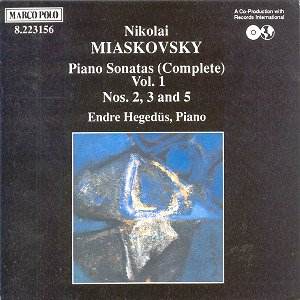
In the Second Sonata Chopin's elegant grace jars with a strenuous
romanticism, Bachian patterning (16.40) and the Dies Irae thunders
and glowers framed by Klimt-like textures - all starry robes and subtle smiles.
Moving onwards to the fateful and deathly year 1917, the Fifth Sonata
is in four movements. The guileless Mozartian pastoralism of the first
movement reminded me of the gangling and generous 'summertime' theme from
the finale of Prokofiev's Seventh Symphony. Miaskovsky's downbeat elegiac
character retakes the heights in the Largo only to be dispelled by
the Handelian/Graingerian ripple of the Vivo which has a real roll
and sway to it in Hegedüs's hands. The finale strides, elbows wide,
through the heroic uplands in a true Romantic style also exemplified by the
Sonata-Triad of Medtner or the Corelli Variations of Rachmaninov.
The Third Sonata is again a single movement structure just like its
predecessor. The music is far more luxuriantly coloured and decorated than
the Fifth. Its strenuous conflict-laden strains can be compared with the
first two Bax Sonatas. This work shows the same trend as symphonies numbers
1 to 3 (possibly No. 4 as well, though I have not heard it). Scriabin is
the exemplar and there is a density to the music that suggests the heavy
duty romanticism of the times extruded through the pessimism of Tchaikovky's
Pathétique and Manfred.
The sound quality is very healthy and Hegedüs takes care to be delicate
where delicacy is called for. Helpful notes from David Nelson and the cover
illustrations are by my friend Michael Freeman whose paintings appear on
all the Marco Polo Miaskovsky sonata series and also, I believ, their Danubius
Villa-Lobos Quartets series.
Rob Barnett
Vol. 2: Miaskovsky played by Endre Hegedüs
(piano)
Sonata No. 6 in A flat (1930s) [20.15]
Sonata No. 7 in C (1949) [10.36]
Sonata No. 8 in D minor (1949) [13.10]
Sonata No. 9 in F (1949) [12.17]
rec. Ferenc Liszt Music Academy, Budapest, 17-21 Sept 1988
 MARCO POLO 8.223178
[56.50]
MARCO POLO 8.223178
[56.50]
Crotchet
AmazonUK
AmazonUS
Amazon
recommendations
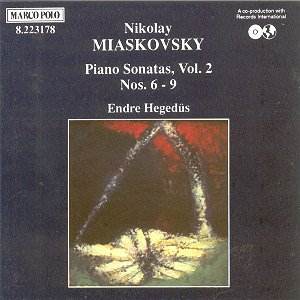
This is puzzling. The exterior sheet of the booklet and the back of the jewel
case declare the contents as above and this is what is on the disc. However
the printing on the disc claims that it is Volume 1 (i.e. sonatas 2, 3, 5).
The internal sheets of the booklet are the same as those of volume 1. There
seems to have been some serious confusion here. However you do get to hear
exactly what the front and back of the jewel case says; it is just that you
are deprived of the liner notes. Perhaps this has now been corrected. Worth
checking. The track numbers read out on the CD player tie in perfectly with
the listings on the back of the jewel case.
The Sixth Sonata is in three movements with an easy romantic stance
... for the most part. The fur-lined ripple of the Andante is marked
con sentimento and so it proves; in fact so much so that Miaskovsky
drifts perilously close to the shoals and reefs of Macdowell. He returns
to these gleaming shallows for the Molto vivo. This movement startles
with its blundering Havergal Brian fanfare. It takes a much more conventional
route than this brusque incipit suggests.
Poulenc might almost have been an influence in the nonchalant first movement
of the very short Seventh Sonata while the Elegiya second saunters
along in hushed Handelian tones. The Dance-Rondo is Russian nationalist
in tone like Bax's Trepak and In a Vodka Shop. This is a light
interlude among the sonatas.
In the Eighth Sonata Hegedüs neatly exploits the Song-Idyll
which uses a sentimental tune of the exalted quality to be found in the
Sixth and Seventh Symphonies. The halting Barkarola-Sonatina movement
is an allegretto. The brief Horovod-Rondo is related to Russian
folksong.
The Ninth Sonata (the final one) is in now familiar Miaskovsky garb
with that easy sway and ripple being part Handelian tranquillity, part
Macdowell's sunny woodland clearings and part fertile Russian earth. These
late works have none of the tonal ambivalence of the terra pellegroso
of symphonies 10 and 13. The vivo sparkles, skips and resolutely
marches along.
Rob Barnett
Vol. 3: Miaskovsky played by Endre Hegedüs
(piano)
Sonata No. 1 in D minor (1907-10) [31.43]
Sonata No. 4 in C minor (1924) [32.12]
rec. Assembly Hall, Italian Cultural Institute, Budapest, 3-11 Aug, 27-28
Dec 1990, 7 Aug 1991
 MARCO POLO 8.223469
[64.04]
MARCO POLO 8.223469
[64.04]
Crotchet
AmazonUK
AmazonUS
Amazon
recommendations
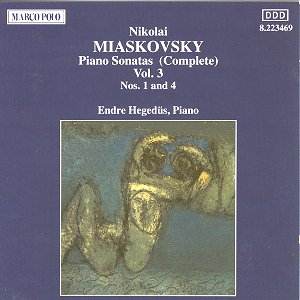
Miaskovsky's sonatas are, quite sensibly, grouped by many writers including
this disc's annotator, David Nelson. However stylistic issues are clouded
by the composer's inclination to revise in later years when the romantic
motes and clouds had cleared from his vocabulary. The last three sonatas
- all from 1949 have a simple, folk-naïf air. The early sonatas, like
the early symphonies, inhabit climes frequented by Scriabin and Rachmaninov
and, up to a point, by Medtner.
Is there a certain jerkiness rather than fluency in Hegedüs's version
of the First Sonata? I think so. The first movement is a moderato
assai and it rather clangs and clatters. The venue for the recording
has changed and not for the better. While there is a closer approach to the
listener it tends to claustrophobia. The First Sonata's finale is dense,
a thicket of pianistic challenges: peremptory and craggy - typical of the
first three symphonies.
In the Fourth Sonata Miaskovsky pushes out the limits of his harmonic
language experimenting in candid dissonance: a Mussorgskian take on Schoenberg
- pecking, hectoring, unrelenting. In this he makes common cause with the
Russian modernists like Mossolov and Goedicke. The Sarabanda andante
is a macabre goblin pavane.
The series of three discs (a joint project with Records International) sits
Cinderella-like, as it has for a decade now, in the Marco Polo catalogue.
It had the misfortune to be issued at the same time as Olympia's cycle. Olympia
(with pianist Murray McLachlan - now championing the piano concertos and
solo music of Erik Chisholm) outpointed Marco Polo on playing time with its
discs covering all the sonatas plus a selection from the more than one hundred
character pieces. The Olympias play for 74.27 OCD214, 73.27 OCD217, 74.05
OCD252. It is time for the Hegedüs cycle to move from the Marco Polo
list to Naxos.
Rob Barnett
McLachlan (Olympia)
Vol. 1: Miaskovsky played by Murray McLachlan
(piano)
Sonata No. 1 in D minor (1907-10) [29.30]
Sonata No. 2 in F sharp minor (1912 rev 1948) [13.35]
Sonata No. 3 in C minor (1920 rev 1939) [13.11]
Sonata No. 6 in A flat (1908 rev 1944) [18.11]
rec 23-25 May 1988, Ski Church Hall, Norway
 OLYMPIA OCD 214
[74.27]
OLYMPIA OCD 214
[74.27]
AmazonUK
£6.99 AmazonUS
Amazon
recommendations
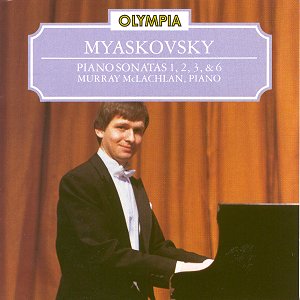
Olympia's sound across all three discs is more imperious than the Marco Polo
equivalent. McLachlan has a more fluid delivery than Hegedüs and in
the First Sonata is also two minutes faster overall without seeming
to scant over the reflective moments. The Sonata is not terribly satisfactory
and has an odds and ends character - seeming unresolved. McLachlan makes
more of the stuttering Non allegro - allegro linking it explicitly
with the Rachmaninov Preludes. In the Third Sonata McLachlan is in
tune with the mildew and evanescent decay of the experimental works that
found their perigee in the Fourth Sonata and Symphonies 10 and 13. This is
more Frank Bridge and Bernard van Dieren than the Macdowell-geniality of
the later works. Hegedüs captures better the music box charm of the
Sixth Sonata though the great slashing challenge of the Molto vivo
is better rendered by McLachlan who also makes a more dynamic fist of
the muscular Second Sonata and its Lisztian diablerie.
Rob Barnett
Vol. 2: Miaskovsky played by Murray McLachlan
(piano)
Sonata No. 4 in C minor (1907) [28.23]
Sonata No. 5 in B major (1907) [21.14]
Sonatine in E minor (1942) [17.21]
Prelude Op. 58 (1940s) [7.01]
rec 27-30 Sept 1988, Ski Church Hall, Norway
 OLYMPIA OCD 217
[74.27]
OLYMPIA OCD 217
[74.27]
AmazonUK
AmazonUS
Amazon
recommendations
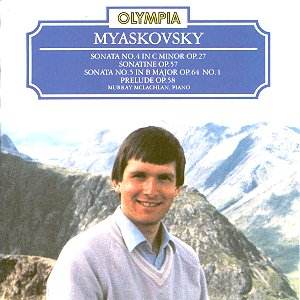
The three Olympia CDs have been reissued in a single set (OCD 704 ABC
DDD 221.59). Given the way that Regis seem to be cherry-picking
through Olympia's sleepier greybeards we must not be surprised if these discs
start to appear there. If they do they will be emphatically unbeatable while
Hegedüs remains on Marco Polo rather than Naxos.
The Fourth Sonata's experimental nightmarish quality flies along through
McLachlan's fingers only marginally faster than Hegedüs but better recorded.
Is it just me or does this second volume have a sound which is not as close
as the first? The soft filigree of the left hand at 2.49 in the Allegro
con brio recalls figures from the piano part at the start of the finale
of Bax's Winter Legends for piano and orchestra.
The Op. 51 Sonatine is new to the scene; not included in the Marco
Polo trilogy. It is a work of the Tbilisi exile years (1942 onwards) where
he stayed with so many other Soviet composers safe from wartime danger and
freed to compose. Like the Op. 58 Prelude and the Rondo-Sonate there is a
ruminative nostalgia here for better times. This language is quite distinct
from Miaskovsky in Soviet-Macdowell mode; more solid, not brittle, closer
to Arthur Bliss than to Bax and Ireland. McLachlan is outstanding in rhythmic
and dynamic skills which are called on in primis in the Molto
vivo.
Moving onwards to the four movement Fifth Sonata the Scriabin references
are now much clearer than they were with Hegedüs. This is the early
Scriabin, gracious and alive with flighty delight as in the Piano Concerto
which I think of as Scriabin's best piece. This sonata is amongst the easiest
of the nine to like; not that the last four are at all hard work but then
they were written as didactic pieces.
The Prelude is spun from melodies that have the same static
introspection as the Satie Gymopédies as well as the stately
pacing of Fauré.
Rob Barnett
Vol. 3: Miaskovsky played by Murray McLachlan
(piano)
Rondo-Sonata in B flat minor (1942) [5.44]
Reminscences (6) (1927) [15.46]
Yellowed Leaves (6) (1929) [13.22]
Scherzo from String Quartet No. 5 (1920s) [3.19]
Sonata No. 7 in C (1949) [10.08]
Sonata No. 8 in D minor (1949) [13.05]
Sonata No. 9 in F (1949) [13.11]
rec 18-19 Dec 1990, Holmbury St Mary Church Hall, England
 OLYMPIA OCD 252
[74.05]
OLYMPIA OCD 252
[74.05]
AmazonUK
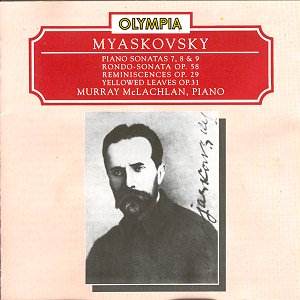
Here Olympia switch recording halls for volume 3. They abandon Norway and
move to a British church hall. Marco Polo also decamped and moved their set
up to a different location for their volume 3 although they stayed in Budapest
with Hegedüs.
The bravura Rondo-Sonata, another legacy of the Tbilisi years
(and, by the way, not at all exotic), is perfectly weighted, clear of texture,
bright-eyed and heroic. Then come the two short and very accessible sonatas:
numbers 8 and 9, each no more than 14 minutes long. The ten
minute Seventh comes later. The Chorale-Rondo (No. 8) manages
to pull off Mozartian and Russian folkishness. The six Reminiscences
(1927): No. 1 simple grace with some harmonic spice; No. 2 like one
of Rachmaninov's more virtuosic Preludes - tense and macabre; No.
3 pessimistic journeying; No. 4 Chopin-like with surprises in the tonality;
a thoughtful lentamente with depressive tendencies; No. 6 - a Godowskian
flight superbly powered and flighted by McLachlan. Yellowed Leaves
Op. 31: No. 1 a hypnotic, tolling Andante; No. 2 tending to
reflection; No. 3 andante cantabile; No. 4 fanciful Godowskian revels
with a collapse into dark realms; No. 5 a haunting Molto calmo resolved
in poised crystal clarity. No. 6 rapid insectile wingbeats pave the way for
a noble tune touched with Celtic beauty. Aliawdina's transcription of the
Scherzo from the String Quartet No. 5 - a popular work in the
old USSR - reminds us of Rimsky's Bumble Bee flight before taking
refuge in Miaskovsky's warmed and warming dewy nostalgia. Why do we not hear
this piece at music competitions?
Rob Barnett
OVERVIEW
As things stand the recommendation has to go to the Olympia discs which are
more generously timed and which have the perceptive virtuosic strengths of
McLachlan. Hegedüs is no mean player and he is given a warmer and less
objective image by the Marco Polo engineers by comparison with McLachlan's
Olympia team. His recordings give great pleasure however McLachlan's power,
verve and sensitivity are to be preferred. When the three Marco Polos drop
to the Naxos price range things will be more evenly balanced.

